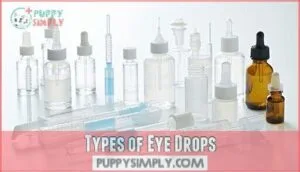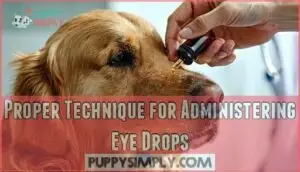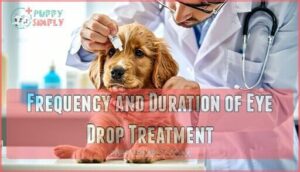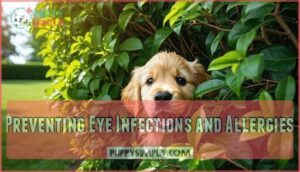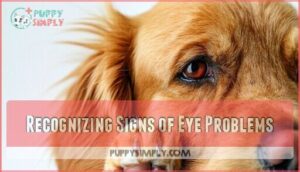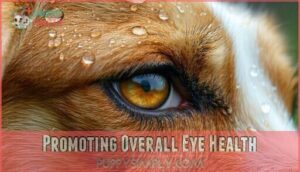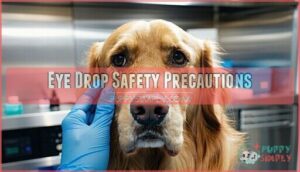This site is supported by our readers. We may earn a commission, at no cost to you, if you purchase through links.
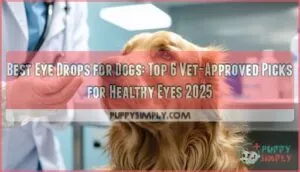
Vetericyn Plus Eye Wash stands out for general cleaning and minor irritation.
For tear stains, Burt’s Bees offers a gentle natural formula.
Dogs with dry eyes benefit from hyaluronic acid drops that provide lasting moisture.
Always choose veterinary-approved products over human eye drops, which can harm your dog’s delicate eye tissues.
Look for preservative-free options if you’ll use them frequently.
The key is identifying whether your dog needs basic cleaning, infection treatment, or ongoing moisture support before selecting a product.
Table Of Contents
- Key Takeaways
- Dog Eye Care Basics
- Choosing Eye Drops
- Types of Eye Drops
- 6 Best Eye Drops for Dogs
- Applying Eye Drops Correctly
- Maintaining Healthy Dog Eyes
- Eye Drop Safety Precautions
- Frequently Asked Questions (FAQs)
- What can I give my dog for gunky eyes?
- What is the best eye drops for dogs?
- How to put eye drops or ointments in your pet?
- What are antibiotic eye drops for dogs?
- What are the best eye drops for a dog?
- Can human eye drops be used on dogs?
- What is a home remedy for dog eye drops?
- Which human eye drops are safe for dogs?
- What are the best drops for dry eyes in dogs?
- What do vets give dogs for eye infections?
- Conclusion
Key Takeaways
- Choose vet-approved products over human drops – Human eye drops contain ingredients like tetrahydrozoline that can cause dangerous blood pressure drops and toxicity in dogs, while veterinary formulas are specifically designed for canine eye tissues.
- Match the product to your dog’s specific condition – Use saline washes for general cleaning, hyaluronic acid drops for dry eyes, and prescription antibiotics for infections rather than applying a one-size-fits-all approach.
- Look for preservative-free options for frequent use – Dogs requiring daily eye care benefit from preservative-free formulas that won’t cause irritation with repeated applications.
- Apply drops correctly and monitor your dog’s response – Gently restrain your pet, aim the dropper without touching the eye, and watch for signs of improvement or adverse reactions that require immediate veterinary attention.
Dog Eye Care Basics
You need to check your dog’s eyes often for redness, discharge, or swelling, as these can signal problems.
Regular cleaning and early attention to changes help prevent infections and keep your dog’s eyes healthy.
Common Eye Problems in Dogs
Dog eye problems can sneak up on you.
Common issues include dog eye injuries, cataracts in dogs, and glaucoma symptoms.
Some breeds have breed predispositions to progressive retinal atrophy or frequent dog eye infections.
Redness, discharge, or cloudiness signal trouble.
Early use of dog eye drops or eye drops for dogs can help manage many canine eye care concerns, including cataracts.
Importance of Regular Eye Care
With regular eye care for your pet, you help preserve vision, spot issues early, and take preventative measures that boost comfort and quality of life.
Eye care for dogs means more than wiping away tears, it involves consistent canine eye care that helps maintain dog eye health, keeps your companion comfortable.
This supports overall pet eye care routines that prevent bigger problems later, ensuring your pet receives the best possible care for a healthy and happy life with regular eye care and preventative measures.
Signs of Eye Infections in Dogs
Spotting the signs of a dog eye infection early makes a world of difference.
Watch for these four clues:
- Redness or swelling around the eye.
- Discharge that’s yellow, green, or thick.
- Squinting or pawing at the face.
- Excessive tearing or itchy eyes.
Prompt dog conjunctivitis care and dog eye discharge remedies help prevent bigger problems.
Sometimes, these issues are caused by bacterial or fungal pathogens.
Choosing Eye Drops
When you choose eye drops for your dog, you need to match the product to your dog’s specific eye condition and check each ingredient for safety.
It’s important to take into account how easy the drops are to use and if there are any possible side effects.
Considering Your Dog’s Eye Condition
When you’re choosing the best eye drops for dogs, start by thinking about your dog’s Breed Predisposition, Symptom Severity, and any Concurrent Conditions.
Some canine eye conditions have Underlying Causes that need a Veterinary Diagnosis before starting dog eye treatment.
Matching the right product to your dog’s specific dog eye conditions is the heart of good dog eye care.
Evaluating Ingredients and Side Effects
Before you buy, look closely at eye drop ingredients.
Safe ingredients like saline or hyaluronan are key for pet eye drop safety.
Watch out for harmful chemicals that could trigger a side effect or worsen symptoms.
Always ask for a veterinary consultation to discuss long-term effects.
The best dog eye drops balance eye drop safety and effectiveness for your pet’s needs.
Ease of Use and Application Method
After checking ingredients and side effects, think about how easy the best dog drops are to use.
Eye drop application depends on your dog’s cooperation, your own dexterity, and the product packaging. Look for pet eye drops with simple application techniques, clear drop size, and bottles you can handle.
Good eye drop application techniques make dog eye drops less stressful for both of you.
Some pet owners explore cataract eye drops as a non-surgical option.
Types of Eye Drops
You can choose from several types of eye drops for your dog, including over-the-counter saline washes, prescription medications, and antibiotic gels.
Each type targets different eye problems and contains specific ingredients to address infection, dryness, or irritation.
Over-the-Counter Non-Medicated Eye Drops
Many pet owners turn to safe eye drops like saline eye washes or natural eye drops for daily pet eye health.
These over-the-counter options use safe ingredients, including hyaluronan and glycerin, offering artificial tear benefits and acting as a dog eye lubricant.
Eye wash for dogs helps flush debris, soothe mild irritation, and support comfort, but won’t treat infections.
For bacterial infections like pink eye, your vet may prescribe antibiotic eye drops.
Prescription Eye Drops for Dogs
Prescription veterinary eye drops are essential for conditions like glaucoma treatment, keratitis management, and chronic dry eye.
Professional vet care ensures your dog gets the right eye drops for serious conditions that need expert diagnosis.
Vet recommended drops include antiinflammatory drops, steroid medications, and dog eye medication for immune-related issues.
It’s important to note that only saline eye drops are considered safe for dogs among over-the-counter human options.
Always follow veterinary oversight, as steroid risks and antibiotic resistance can arise, and regular monitoring guarantees safety.
Only use veterinary eye drops, never substitute human products, to protect your dog’s eyes.
Antibiotic Eye Drops and Gels
When your dog faces Bacterial Infections, antibiotic eye drops or gels offer targeted eye infection treatment.
These dog eye medications, like gentamicin or terramycin, deliver high doses right where they’re needed.
Always follow Application Guidelines and complete the course to prevent Antibiotic Resistance.
Watch for Side Effects and rely on Veterinary Oversight for safe, effective dog eye treatment and eye drops for pets.
6 Best Eye Drops for Dogs
You need eye drops that work well and are safe for your dog’s eyes. Here are six options that address dryness, irritation, infection, and routine cleaning.
1. Dog Eye Drops Hyaluronic Acid
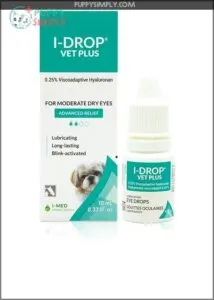
One reliable option for soothing dry, irritated eyes in dogs is hyaluronic acid eye drops.
These drops mimic natural tears, providing long-lasting moisture and comfort.
They help wash away dust, debris, and allergens, making them useful for daily care or after walks.
Hyaluronic acid also supports healing for minor injuries and reduces redness.
Most dogs tolerate these drops well, even those with sensitive eyes.
Preservative-free options are available for long-term use.
Always follow your vet’s directions for the best results, and consider preservative-free options for long-term care.
Best For: Dogs with dry eyes, irritation, or chronic eye conditions needing gentle, lasting moisture and relief.
- Not a cure for underlying dry eye diseases—may need prescription meds too.
- Pricier than some basic alternatives.
- Rare side effects can include mild stinging or redness.
- Mimics natural tears for soothing, long-lasting lubrication.
- Helps remove debris and allergens, supporting healing and comfort.
- Well tolerated by most dogs, with preservative-free options available.
2. Dog Eye Rinse Gentle Formula
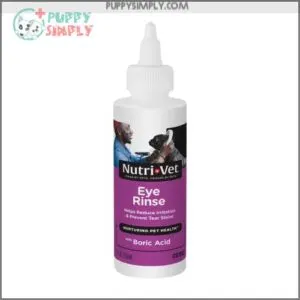
This gentle rinse works like a charm for daily eye maintenance.
You’ll find it removes debris and dried mucus while reducing tear stains effectively.
The formula contains diluted boric acid for gentle cleansing without harsh chemicals.
Most dogs tolerate it well with minimal fuss.
Apply 2-3 drops per eye for routine care or after exposure to irritants.
Over 78% of users report visible improvements in eye clarity and reduced staining within days of consistent use, making it a great solution for daily eye maintenance.
Best For: Dogs who need daily eye cleaning, relief from irritation, or help with tear stains.
- Doesn’t replace veterinary care for serious eye problems.
- Needs regular application for best results.
- Overuse or contact with dirty applicators can increase infection risk.
- Gentle, non-irritating formula safe for all breeds and sizes.
- Quickly reduces tear stains, discharge, and redness.
- Easy to use and well-tolerated by most dogs.
3. Sterile Eye Wash for Dogs and Cats

For dogs prone to tear stains and eye discharge, sterile eye wash provides gentle daily cleaning without harsh chemicals.
These isotonic solutions match your dog’s natural tear fluid to prevent stinging, with key ingredients like boric acid and sodium chloride safely removing pollen, dust, and debris from sensitive eye areas.
Most veterinary-approved formulas contain no preservatives, making them suitable for frequent use, and apply by flushing the eye gently and wiping away loosened debris.
Perfect for breeds with prominent eyes needing regular maintenance.
Best For: Dogs and cats who develop tear stains, eye discharge, or irritation—especially breeds with prominent eyes or those often exposed to outdoor allergens.
- Gently removes dirt, debris, and irritants without stinging or harsh chemicals.
- Safe for daily use and well tolerated by sensitive pets.
- Can help reduce tear stains and keep eyes clear and comfortable.
- No tamper-evident safety seal on the bottle, raising product integrity concerns.
- Bottle size may be small for households with multiple pets or frequent use.
- Not a complete treatment for severe or persistent eye problems—veterinary care is still required.
4. Burt’s Bees Dog Tear Stain Remover
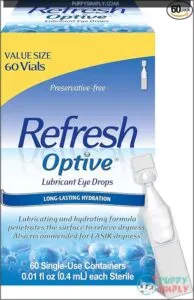
Made from 99.9% natural ingredients, this gentle tear stain remover combines chamomile and dandelion extracts to lighten discoloration around your dog’s eyes.
Natural chamomile and dandelion work gently to fade stubborn tear stains without harsh chemicals.
You’ll need patience—results take 15-30 days of daily use. The pH-balanced formula won’t irritate sensitive skin or interfere with flea treatments.
Simply moisten a cotton pad and gently wipe stained fur. While effective for most dogs, severe staining may require addressing underlying health issues with your vet to ensure the best results, using a formula that is pH-balanced.
Best For: Owners looking for a gentle, natural solution to lighten mild to moderate dog tear stains without harsh chemicals or irritation.
- 99.9% natural ingredients with soothing chamomile and dandelion extracts.
- PH-balanced and safe for daily use, even on puppies and sensitive dogs.
- Won’t interfere with flea/tick treatments or cause fur bleaching.
- Results require daily use for 15–30 days and aren’t guaranteed for all dogs.
- Some breeds or cases of severe staining may see limited improvement.
- Not a treatment for underlying medical issues causing excessive tearing.
5. Dog Eye Cleaner Drops

Multi-purpose dog eye cleaner drops tackle everyday irritants like dust and pollen while supporting natural eye moisture.
These versatile formulas contain gentle ingredients such as boric acid and sodium chloride that provide mild antiseptic properties without causing stinging.
Most products work for both cats and dogs from 12 weeks old. The dropper design prevents accidental eye contact during application.
You’ll typically use 2-3 drops per eye daily or as needed based on environmental exposure.
While some owners seek cataract eye drops, surgery is often the only definitive treatment to restore vision.
Best For: Pet owners looking for a gentle, daily eye cleaner to reduce tear stains and soothe mild irritation in dogs (and cats) without harsh chemicals.
- Mild, non-stinging ingredients safe for daily use on sensitive eyes.
- Convenient dropper design enables easy and precise application.
- Suitable for both dogs and cats, making it ideal for multi-pet households.
- Mixed effectiveness—some users see little to no improvement in tear stains.
- May not address underlying health issues or infections—vet visit still required for persistent problems.
- Some packaging complaints, such as leakage or cap issues during use.
6. Vetericyn Plus Eye Wash for Pets

Featuring hypochlorous acid at 0.009% concentration, Vetericyn Plus Eye Wash delivers powerful antimicrobial action against bacteria, fungi, and viruses.
You’ll appreciate its gentle formula that won’t sting your dog’s sensitive eyes. The electrolyzed water base contains no harsh chemicals, antibiotics, or steroids.
This veterinarian-recommended solution flushes debris while reducing tear stains and conjunctivitis symptoms. Apply 3-4 times daily for active infections or once daily for maintenance.
The adjustable dropper nozzle makes application stress-free for both you and your pet.
Best For: Dogs with red, irritated, or allergy-prone eyes needing a safe, gentle, and effective daily eye wash.
- Soothes and cleanses eyes without stinging or irritation.
- Vet-recommended formula fights bacteria, fungi, and viruses.
- Eases tear stains, mucus, and allergy symptoms with regular use.
- Packaging issues reported, such as broken seals and hard-to-open caps.
- Not eligible for return if damaged in transit.
- Requires frequent applications for best results in active cases.
Applying Eye Drops Correctly
Applying eye drops to your dog requires patience and proper technique to guarantee effective treatment.
You’ll need to restrain your pet gently while positioning the dropper correctly to avoid injury and maximize absorption.
Preparing Your Dog for Eye Drop Application
Your dog’s comfort determines success. Start with calming techniques like gentle petting and soothing voices.
Use positive reinforcement with treats before handling their face. Try gradual introduction by letting them sniff the eye drops for pets bottle first.
Consider restraint methods like wrapping smaller dogs in towels. Distraction strategies work well – have someone offer treats while you position the dog care product.
Many owners find proper eye drops are essential for treatment. Always approach slowly and confidently.
Proper Technique for Administering Eye Drops
Start by securing your dog with gentle but firm Dog Positioning. Hold the upper eyelid open with your non-dominant hand for proper Eyelid Control.
Aim the dropper tip close to the eye without touching for accurate Drop Aiming. Squeeze gently to release the prescribed amount ensuring Dosage Accuracy.
Avoid letting your dog rub their eyes immediately after application for effective Post-Application Care.
Frequency and Duration of Eye Drop Treatment
Treatment duration varies based on your dog’s specific condition and veterinary guidance.
Follow your vet’s prescribed schedule religiously. Most eye drops require application 2-3 times daily for best results.
Key timing considerations:
- Acute infections: 7-14 days with consistent drop frequency
- Chronic conditions: Long-term use with scheduled breaks to prevent side effects
- Maintenance care: Weekly applications for ongoing eye health.
Never extend treatment beyond recommended duration without professional consultation.
Maintaining Healthy Dog Eyes
You can prevent most eye problems through simple daily care and regular monitoring.
Watch for discharge, redness, or changes in your dog’s vision to catch issues before they become serious infections.
Preventing Eye Infections and Allergies
Regular grooming removes debris and reduces Allergen Exposure around your dog’s eyes.
Clean your pet’s face daily with a damp cloth to prevent Environmental Irritants from accumulating.
Some breeds have higher Breed Predisposition to dog eye allergies requiring extra attention.
Conjunctivitis can cause redness and foul-smelling discharge.
Proper Hygiene Practices and Nutritional Support boost immunity against eye infection treatment needs.
Recognizing Signs of Eye Problems
Watch your dog’s eyes closely for these warning signs that indicate canine eye health issues:
- Redness around the eye or eyelids signals irritation or infection
- Discharge that’s yellow, green, or thick suggests bacterial problems
- Squinting or keeping one eye closed shows pain or discomfort
- Pawing at the face means something’s bothering their eye
Cloudiness in the eye can indicate serious conditions. These dog eye problems need prompt attention to prevent complications.
Promoting Overall Eye Health
You can support your dog’s eye health for dogs through simple daily habits.
Diet impact plays a vital role in canine eye health.
Vision supplements containing antioxidants help protect against age-related changes.
| Preventative Measures | Benefits |
|---|---|
| Regular Checkups | Early detection of problems |
| Breed Predispositions | Targeted monitoring for risks |
| Vision Supplements | Antioxidant protection |
| Proper Diet | Essential nutrients for eyes |
Pet eye treatment starts with prevention.
Veterinary eye care includes routine screenings.
Eye care for pets requires consistent attention to environmental factors and nutrition.
Eye Drop Safety Precautions
Using human eye drops on dogs can cause serious harm or toxicity.
Monitor your dog closely after applying any eye drops and watch for signs of irritation, excessive blinking, or worsening symptoms that require immediate veterinary attention.
Avoiding Human Eye Drops for Dogs
Human eye drops pose serious risks to dogs due to ingredient toxicity and dosage differences.
Your dog’s unique physiology can’t handle chemicals designed for humans.
Human Drop Dangers include:
- Tetrahydrozoline causes dangerous blood pressure drops in dogs
- Preservatives like zinc sulfate are toxic to pets
- Drug concentrations exceed safe levels for canine tissues
Veterinary alternatives offer safer pet eye treatment options.
Long-term effects from human eye medication for pets can include cardiovascular problems and neurological damage.
Always choose veterinary eye care products specifically formulated for eye drops for animals.
Monitoring Your Dog’s Response to Eye Drops
After applying canine eye drops, watch for visual cues like increased redness or discharge.
Note behavioral changes such as excessive pawing or blinking.
Most pet eye medication shows improvement within days, but adverse reactions require immediate veterinary follow-up.
Monitor eye drop effectiveness throughout treatment duration to guarantee your dog’s comfort and healing progress.
Potential Challenges and Solutions
Application difficulties often frustrate dog owners when pets resist eye drop treatments. Owner compliance drops when dogs struggle or show eye drop side effects.
Cost concerns arise with prescription medications for veterinary eye problems. Misdiagnosis risks increase when owners self-treat serious pet eye problems.
Resistance development can occur with antibiotic overuse. Monitor eye drop effectiveness closely and consult your vet immediately if eye problems for dogs worsen despite treatment. It is crucial to address these issues to prevent further complications and ensure the well-being of your pet.
Frequently Asked Questions (FAQs)
What can I give my dog for gunky eyes?
You see those crusty, sticky deposits clinging to your pup’s eyelids like unwelcome guests.
Start with saline eye washes to gently flush debris.
Use veterinary-approved artificial tears for dry eyes.
Consult your vet for persistent discharge.
What is the best eye drops for dogs?
You’ll want vet-approved saline washes for flushing debris or artificial tears like I-DROP VET PLUS for dry eyes. Avoid human drops containing tetrahydrozoline. Prescription antibiotics treat infections effectively.
How to put eye drops or ointments in your pet?
Gently restrain your pet and approach from the side.
Pull down the lower eyelid to create a pocket.
Squeeze drops into this space without touching the eye.
Hold the eyelid closed briefly for absorption.
What are antibiotic eye drops for dogs?
Antibiotic eye drops treat bacterial infections in your dog’s eyes.
Vets prescribe medications like ciprofloxacin, gentamicin, or terramycin to combat conjunctivitis and keratitis.
You’ll need a prescription since these aren’t available over-the-counter, and it’s essential to follow the vet’s instructions for medications.
What are the best eye drops for a dog?
Your dog’s eyes deserve liquid gold treatment! Saline washes flush debris safely.
Artificial tears like I-DROP VET treat dry eyes. Prescription antibiotics fight infections.
Never use human drops containing tetrahydrozoline – they’re toxic to dogs, and using the right treatment, such as artificial tears, is crucial.
Can human eye drops be used on dogs?
Human eye drops aren’t safe for your pup.
Human ingredients can harm dogs. Only saline drops and artificial tears are safe options.
Always consult your vet first before using any drops on your furry friend’s eyes.
What is a home remedy for dog eye drops?
You can make safe homemade eye drops using distilled water and a pinch of salt to create a gentle saline solution for flushing debris and irritants from your dog’s eyes.
Which human eye drops are safe for dogs?
You’ll want to stick with saline solutions only.
Most human eye drops contain ingredients that can harm your dog’s eyes.
Skip drops with preservatives or medications like Visine.
Plain sterile saline is your safest bet.
What are the best drops for dry eyes in dogs?
Tears become windows to relief when your pup’s eyes feel parched.
Vets typically prescribe cyclosporine or tacrolimus drops to boost tear production naturally.
I-DROP VET PLUS with hyaluronan provides excellent artificial lubrication for dry eye symptoms.
What do vets give dogs for eye infections?
Vets typically prescribe antibiotic eye drops like terramycin, gentamicin, or ciprofloxacin for bacterial infections.
They’ll examine your dog’s eye first to determine the specific cause and prescribe the right treatment accordingly.
Conclusion
Protecting your dog’s vision becomes a daily ritual when you choose the best eye drops for dogs.
Regular eye care prevents minor irritations from becoming serious problems. You now have six proven options that veterinarians trust.
Each product targets specific needs from basic cleaning to moisture support. Remember to avoid human eye drops and always consult your vet for persistent issues.
Your dog’s bright eyes deserve this simple yet essential care routine.
- https://www.allaboutvision.com/eye-care/pets-animals/eye-drops-for-dogs/
- https://imedanimalhealth.com/products/i-drop-vet-gel
- https://www.petmd.com/dog/conditions/eyes/c_dg_conjunctivitis
- https://www.northwestanimaleye.com/site/blog/2022/04/15/can-i-use-human-eye-drops-for-my-dog
- https://www.reddit.com/r/Bulldogs/comments/1bztk70/eye_drop_recommendation/


